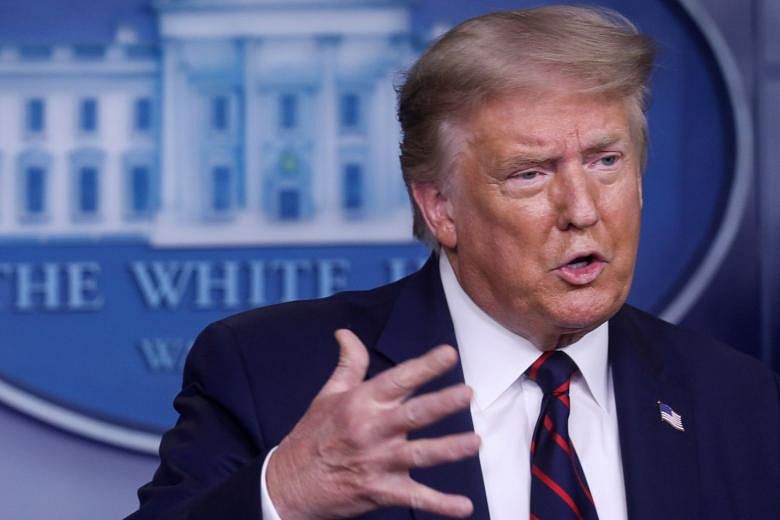WASHINGTON - President Donald Trump on Tuesday (July 21) said the coronavirus situation in America would worsen before improving and encouraged Americans to wear masks, breaking with his earlier optimism that the virus would disappear and his reluctance towards masks.
His shift in tone during his return to the White House briefing room podium after a long hiatus appeared to be an attempt to regain the political narrative, as coronavirus cases and deaths surge in America.
The reversal from his initial downplaying of the seriousness of the virus comes amid a spate of polls showing his Democrat opponent Joe Biden expanding his lead over Mr Trump into the double digits, less than four months to the November election.
The United States recorded over 1,000 deaths on Tuesday, the first time it had crossed that single-day mark since the start of June.
It has almost 4 million confirmed cases, but the true number of infections could be two to 13 times higher, according to a Centres for Disease Control and Prevention study published on Tuesday.
Mr Trump said as he opened the briefing on Tuesday: "It will probably, unfortunately, get worse before it gets better. Something I don't like saying about things, but that's the way it is."
He had tweeted that wearing masks was "patriotic" and posted a photo of himself wearing a mask on Monday after months of choosing not to wear one.
"We're asking everybody that when you are not able to socially distance, wear a mask, get a mask," he said at Tuesday's briefing. "Whether you like the mask or not, they have an impact."
The briefing was relatively short, lasting around 30 minutes, and focused mostly on his administration's response to the coronavirus, unlike some of his previous briefings which could last hours and included attacks on Democrats and media organisations.
He previously helmed those briefings almost daily in March, when the pandemic first spiked in America.
But he stopped doing so in April after a backlash to his suggestion that disinfectants could be injected into Covid-19 patients to treat them.
He may well see the briefings as a way to reach more voters and drum up support for himself, especially since the pandemic curtails attendance at in-person rallies.
On Monday, he told reporters in the Oval Office as he announced the return of the briefings: "I was doing them and we had a lot of people watching, record numbers watching in the history of cable television, and there's never been anything like it.
"It's a great way to get information out to the public as to where we are with the vaccines and the therapeutics," he said.
"We had a good slot. A lot of people were watching."
But one criticism he drew at the briefing was the absence of a clear national plan to combat the coronavirus.
"We are in the process of developing a strategy that's going to be very, very powerful. We've developed them as we go along," he said, without giving further details.
This could disadvantage him against Mr Biden, who voters rate higher in responding to the coronavirus and who is also trying to seize the narrative.
Hours before the Tuesday briefing, the former vice-president announced a US$775 billion (S$1.07 trillion) economic plan focusing on affordable caregiving, which he linked to America's economic recovery.
In his speech broadcast online, he blasted Mr Trump's approach, saying: "This man simply doesn't understand. He can't deal with our economic crisis without serving and saving and solving the public health crisis.
"For all his bluster about his expertise on the economy, he's unable to explain how he'll actually help the working families hit the hardest. You know, he's quit on you, and he's quit on this country," said Mr Biden.
A Quinnipiac University poll on July 15 found that 57 per cent of Americans think Mr Biden would do a better job handling a crisis, compared to 38 per cent who say the same of Mr Trump.
The same poll showed that 62 per cent of voters think Mr Trump is hurting rather than helping efforts to slow the spread of the coronavirus.
Some of his mixed messages also continued on Tuesday, raising questions about whether the President can turn around his re-election bid and turn the tide against the coronavirus.
When answering a question from a reporter, he repeated his earlier messages that the virus will disappear.
He also did not wear a mask at the briefing, despite showing reporters he was carrying one and saying he had no problem with wearing it.
Georgetown University's global health law professor Lawrence Gostin wrote on Twitter that Mr Trump's sudden support for masks was too little, too late, as there had been "countless mixed messages".
"We've failed in clear consistent health messages leaving Americans confused and bitterly divided," he said.












